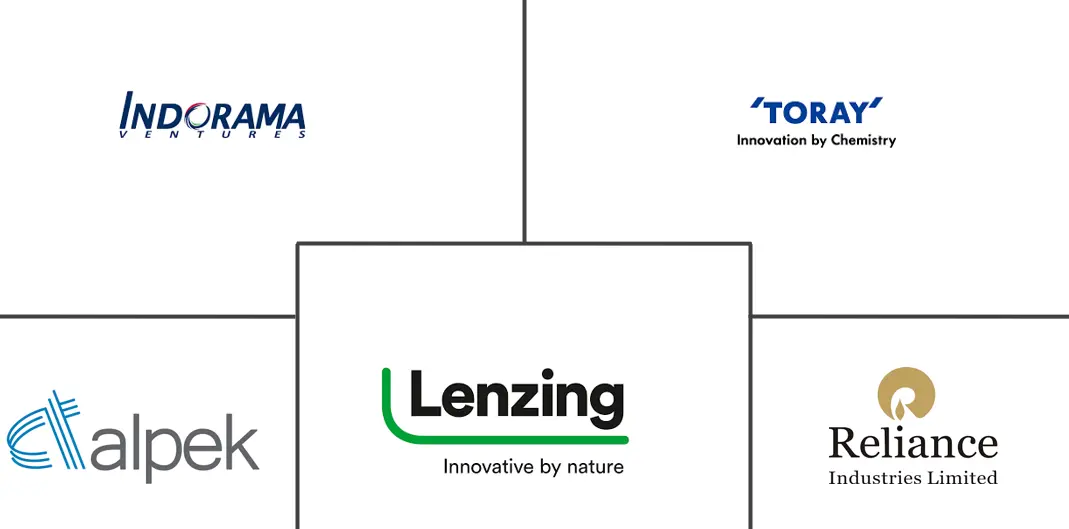Recycled Synthetic Fiber Market Size and Share
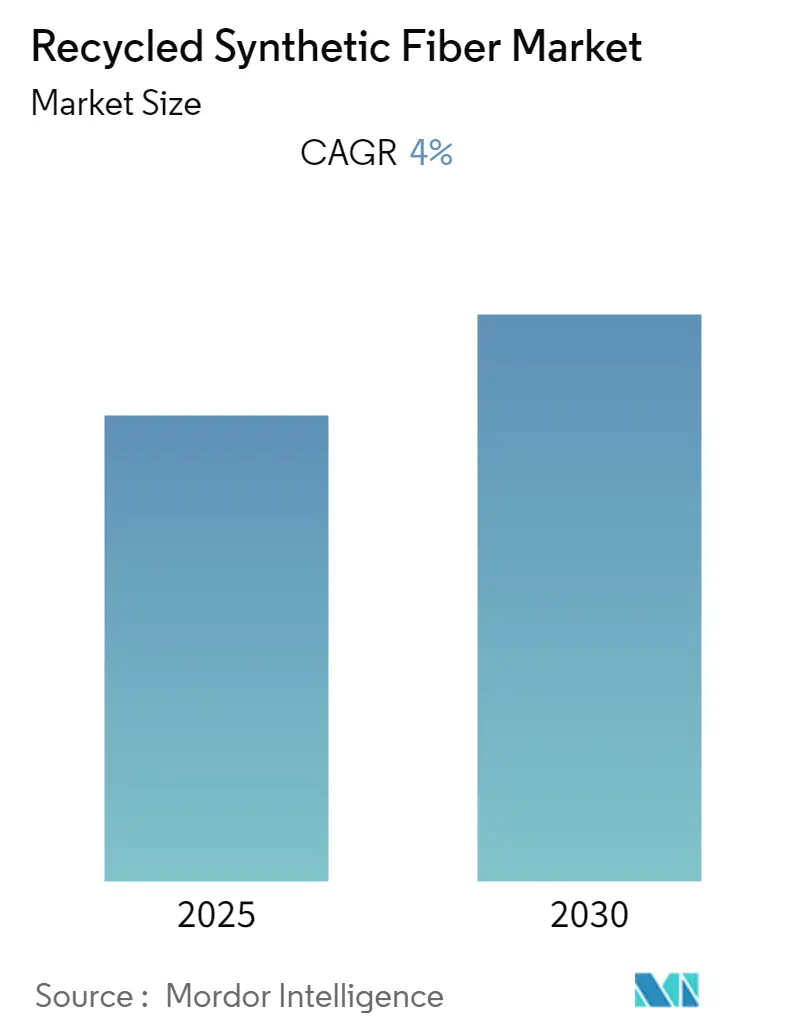
Recycled Synthetic Fiber Market Analysis by Mordor Intelligence
The Recycled Synthetic Fiber Market is expected to register a CAGR of 4% during the forecast period.
In 2020, COVID-19 had a detrimental effect on the market. During the pandemic scenario, textile and automotive manufacturing activities were temporarily halted during the lockdown to curb the spread of new COVID-19 cases, thereby decreasing the consumption of synthetic fibers in these end-user industries. However, the condition recovered in 2021, which is expected to benefit the market during the forecast period.
- Over the short term, increasing awareness of sustainable materials is expected to drive the market's growth.
- On the flip side, the non-biodegradability of synthetic fibers tends to act as a restraint on the growth of the market.
- Rising urbanization and increasing customer interest in home furnishings act as opportunities for the growth of the market in the near future.
- Asia Pacific dominated the market globally, with the largest consumption from construction activities in countries such as India, China, and others.
Global Recycled Synthetic Fiber Market Trends and Insights
Clothing Application to Dominate the Market
- The two most common forms of recycled synthetics are recycled polyester and recycled nylon polyamide. Recycled polyester is obtained by melting down existing plastic and re-spinning it into new polyester fiber.
- The global fiber market is dominated by polyester, as the production of one ton of recycled polyester saves 11,100 kWh of energy, equivalent to two years of energy consumption for an average household.
- Recycled synthetic fibers such as polyester and nylon are widely used in the textile and apparel industries to make fabrics for athletic and fashion clothing. It contains recycled plastic fibers extracted from PET plastic bottle waste.
- In 2021, synthetic fibers accounted for approximately 64% of the global textile fiber production volume. Among all the types of synthetic fibers, polyester alone had a market share of 54%, while polyamide and other synthetics accounted for 5% each. The demand for polyester fibers is expected to reach 63 million metric tons by the end of 2023.
- These synthetic fibers can be recycled mechanically and chemically. For instance, polyester is pulverized, melted, and then spun into new fibers. The demand for recycled polyester is high in the niche markets of sports and outdoor wear, as well as in the fashion industry.
- According to TOAD&CO, a United States-based manufacturer of eco-friendly clothing, it takes about nine bottles to make one T-shirt. All the recycled polyester fibers from the company are made from 100% post-consumer plastic bottles with the Global Recycling Standard (GRS) certification.
- According to Textile Exchange, in 2021, 109 brands and retailers and 23 suppliers and manufacturers, including Adidas, Reebok, H&M Group, and others, committed to using 45% to 100% recycled polyester fibers in their products by 2025.
- In 2022, H&M increased the amount of recycled materials in products to 24% and the share of more sustainably sourced materials to 84%, making good progress towards achieving the sustainable goals.
- According to the company, the compounds used to make these fibers come from fossil-fuel-derived resources. The company aims to phase out virgin polyester by 2025, primarily using textile-to-textile recycling. In 2022, 74% of the total polyester production came from recycled sources.
- According to statistics from the Textile Exchange, recycled polyester represents 14% of fashion's polyester market. By 2025, the total recycled polyester capture is expected to be at least 45%. There is a long-term vision to bring this number up to 90% by 2030.
- Therefore, the above-mentioned pointers are expected to fuel the demand for synthetic fibers globally in the years to come.
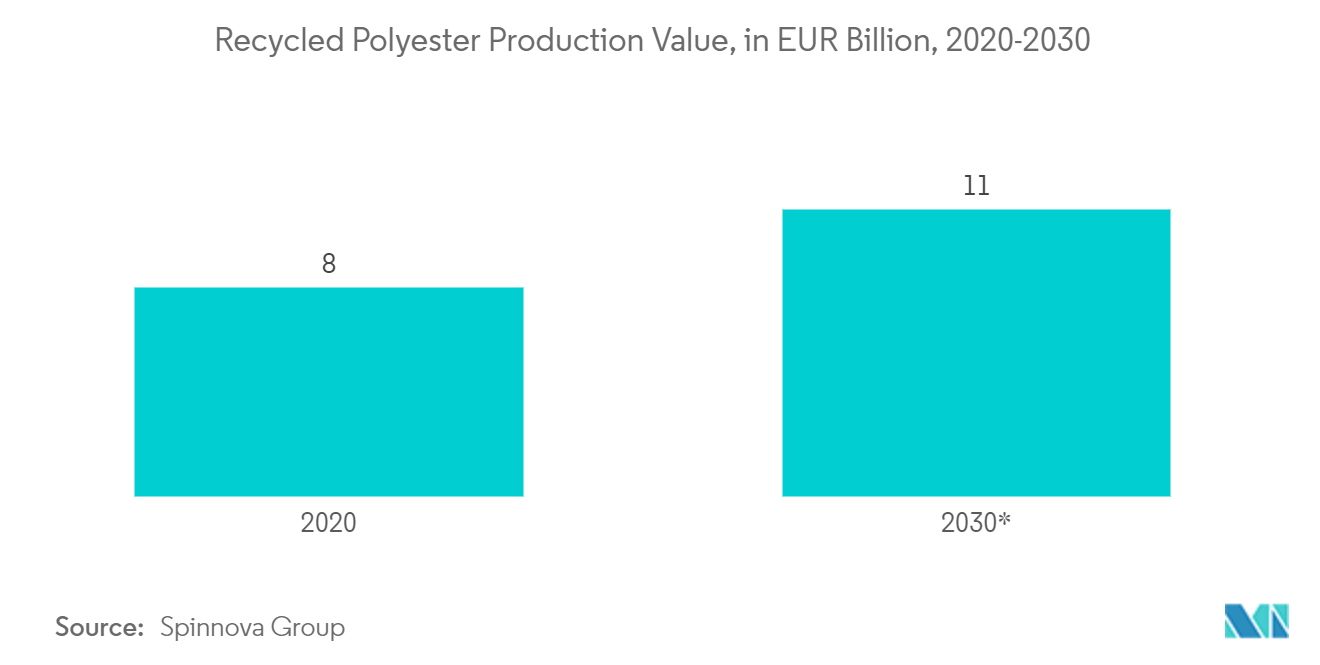
Asia-Pacific Region to Dominate the Market
- Asia-Pacific is anticipated to dominate the market owing to its massive growth in the clothing and automotive sectors.
- The increasing use of polyester fiber in sportswear, activewear, and others is driving its demand in the garment industry, propelling the growth of the market. Polyester fiber demand is also benefiting from a surge in its use as a cotton alternative due to its cost, thinness, and availability in various styles and colors.
- The volume of the apparel market in the Asia-Pacific region is expected to amount to 97.08 billion pieces by 2027. The revenue in the sports and outdoor wear segment is projected to reach USD 38.75 billion by the end of 2023.
- In October 2022, approximately three billion meters of clothing fabric were produced in China. According to the National Bureau of Statistics (NBS), the textile production volume reached an all-time high of USD 46 billion in November 2022.
- In fiscal year 2021, the production volume of synthetic fibers across India amounted to about 3.2 million metric tons, a decrease of 18.2% in comparison to the previous year.
- The textile industry in India is one of the oldest and most crucial sectors. According to the International Trade Administration, India is the world's second-largest manufacturer of textiles after China. In 2021, India exported textiles and apparel for USD 209.63 million, a 30% increase as compared to the previous year.
- In 2022, China's exports of polyester yarn reached a new high. The total export of polyester yarn was 535 kt, up 15% year over year. Whereas, the total imports were 2kt, down 49.9% year on year.
- Therefore, the aforementioned factors are expected to boost the demand for synthetic fiber in the Asia-Pacific region in the coming years.
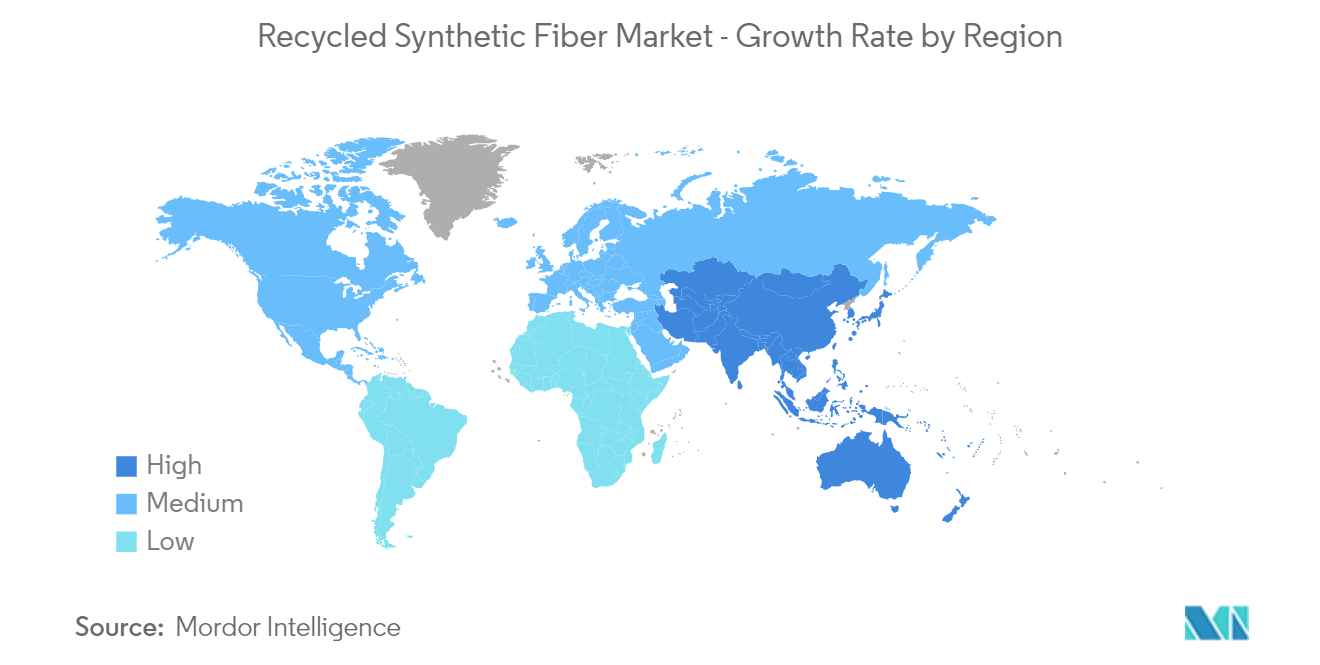
Competitive Landscape
The recycled synthetic fiber market is partially consolidated in nature. The major companies include Indorama Ventures Public Company Limited, TORAY INDUSTRIES, INC., LENZING AG, Reliance Industries Limited, and Alpek S.A.B. de C.V., among others.
Recycled Synthetic Fiber Industry Leaders
Indorama Ventures Public Company Limited
TORAY INDUSTRIES, INC.
LENZING AG
Reliance Industries Limited
Alpek S.A.B. de C.V.
- *Disclaimer: Major Players sorted in no particular order
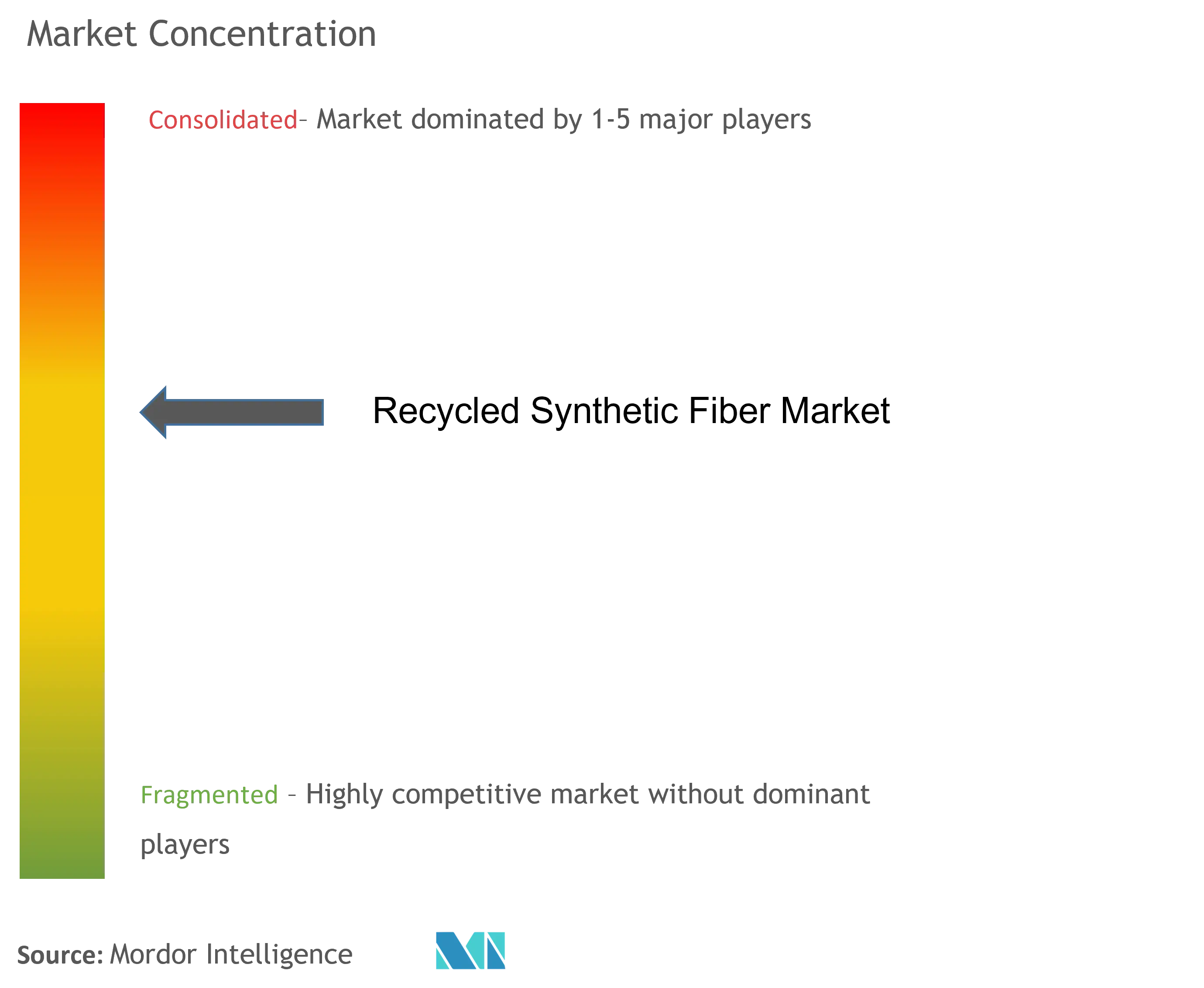
Recent Industry Developments
- December 2022: Toray Industries, Inc. announced plans to sell its nylon 6 chemically recycled fiber (N6CR) yarns, textiles, and other products in Japan from March 2023. The products were expected to be produced by applying the company's depolymerization and repolymerization technology to recycled plastics recovered by Refineverse Group, Inc.
- October 2022: Reliance Industries Limited, the world's largest producer of polyester fibers and yarns, enhanced its sustainable edge of well-established fire-resistant polyester, Recron FS, with the help of FRX Innovations' Nofia technology.
Global Recycled Synthetic Fiber Market Report Scope
Synthetic fibers are made from the polymers that are found in natural gas and the by-products of petroleum. Pre- or post-consumer synthetic fiber waste is used for the manufacturing of recycled synthetic fibers. Polyester and nylon polyamide are the two most common types of recycled synthetics. The recycled synthetic fiber market is segmented by type, application, and geography. By type, the market is segmented into nylon, polyester, polyolefins, acrylics, and other synthetic fibers. By application, the market is segmented into automotive, clothing, medical, aerospace, home furnishing, filtration, and others. The report also covers the market size and forecasts for the recycled synthetic fiber market in 15 countries across major regions. For each segment, market sizing and forecasts have been done based on revenue (USD million).
| Nylon |
| Polyester |
| Polyolefins |
| Acrylics |
| Other Synthetic Fibers |
| Automotive |
| Clothing |
| Medical |
| Aerospace |
| Home Furnishing |
| Filtration |
| Other Applications |
| Asia-Pacific | China |
| India | |
| Japan | |
| South Korea | |
| Rest of Asia-Pacific | |
| North America | United States |
| Canada | |
| Mexico | |
| Europe | Germany |
| France | |
| United Kingdom | |
| Italy | |
| Rest of the Europe | |
| South America | Brazil |
| Argentina | |
| Rest of South America | |
| Middle-East and Africa | Saudi Arabia |
| South Africa | |
| Rest of Middle-East and Africa |
| Type | Nylon | |
| Polyester | ||
| Polyolefins | ||
| Acrylics | ||
| Other Synthetic Fibers | ||
| Application | Automotive | |
| Clothing | ||
| Medical | ||
| Aerospace | ||
| Home Furnishing | ||
| Filtration | ||
| Other Applications | ||
| Geography | Asia-Pacific | China |
| India | ||
| Japan | ||
| South Korea | ||
| Rest of Asia-Pacific | ||
| North America | United States | |
| Canada | ||
| Mexico | ||
| Europe | Germany | |
| France | ||
| United Kingdom | ||
| Italy | ||
| Rest of the Europe | ||
| South America | Brazil | |
| Argentina | ||
| Rest of South America | ||
| Middle-East and Africa | Saudi Arabia | |
| South Africa | ||
| Rest of Middle-East and Africa | ||
Key Questions Answered in the Report
What is the current Recycled Synthetic Fiber Market size?
The Recycled Synthetic Fiber Market is projected to register a CAGR of 4% during the forecast period (2025-2030)
Who are the key players in Recycled Synthetic Fiber Market?
Indorama Ventures Public Company Limited, TORAY INDUSTRIES, INC., LENZING AG, Reliance Industries Limited and Alpek S.A.B. de C.V. are the major companies operating in the Recycled Synthetic Fiber Market.
Which is the fastest growing region in Recycled Synthetic Fiber Market?
Asia-Pacific is estimated to grow at the highest CAGR over the forecast period (2025-2030).
Which region has the biggest share in Recycled Synthetic Fiber Market?
In 2025, the Asia-Pacific accounts for the largest market share in Recycled Synthetic Fiber Market.
What years does this Recycled Synthetic Fiber Market cover?
The report covers the Recycled Synthetic Fiber Market historical market size for years: 2019, 2020, 2021, 2022, 2023 and 2024. The report also forecasts the Recycled Synthetic Fiber Market size for years: 2025, 2026, 2027, 2028, 2029 and 2030.
Page last updated on:
Recycled Synthetic Fiber Market Report
Statistics for the 2025 Recycled Synthetic Fiber market share, size and revenue growth rate, created by Mordor Intelligence™ Industry Reports. Recycled Synthetic Fiber analysis includes a market forecast outlook for 2025 to 2030 and historical overview. Get a sample of this industry analysis as a free report PDF download.
